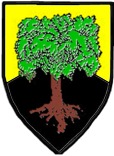Contrast
SCA Armory is expected to exhibit good contrast between charges and the ground upon which they lie. This lesson will discuss armorial contrast.
The Rules for Submissions defines good contrast in terms of colors, metals, and combinations of the two.
To review:
- Colors are "dark", and are Sable, Gules, Vert, Azure, and Purpure.
- Metals are "light", and are Or and Argent.
- Neutral is evenly composed of "light" and "dark".
In a sense, it is a black, white, and gray issue.
SCA heraldic practice treats furs differently from mundane heraldic practice. Ermine and its variations are treated for contrast as if the spots were not present. That is, ermine is functionally Argent, while Pean is functionally Sable. Vair and other furs that are evenly divided are treated as neutral.
There is good contrast between a light tincture and a dark tincture. There is usually good contrast between a neutral tincture and a light or dark tincture.
If a
field or object is being divided in two parts, quarterly, or per saltire, there
may be low contrast between the parts, that is, two metals or two colors.
However, if the line of division is bumpity (non-straight), some combinations of
tinctures have such low contrast as to be unusable. Consider, "Per fess wavy
sable and purpure". Officially, there is low contrast between the
tinctures. In fact, the contrast is so low that the nature of the bumpity line
is almost impossible to see under reasonable viewing conditions. For this
reason, this combination is unusable with a bumpity line.
On the other hand, "Per bend indented gules and sable" has sufficient contrast to allow an observer to see the nature of the bumpity line.
Neutral tinctures seem to cause the most confusion with contrast. The rules allow any combination of a neutral tincture and a color or metal, as long as the charge remains identifiable.
For example, "a lion rampant barry azure and argent" has a neutral tincture. This particular charge could be placed on most any field. However, consider an azure field or an argent field. Now, half of the lion is the same tincture as the field. This renders the lion unidentifiable. In addition, this charge would be unidentifiable on any divided field containing azure or argent.
As another example, consider "a bordure compony gules and Or." This bordure has a neutral tincture but is unusable on an Or or gules field.
Note in both examples that the problems crop up when the neutral tincture shares a tincture with the color or metal. As a rule of thumb, a neutral tincture will not have sufficient contrast with either of its component tinctures.
Of course, there are exceptions.
The term compony is used to describe a long ordinary or similar object that is divided into blocks that alternate between two tinctures.
Counter-compony means that there are two rows of blocks, while checky means at least three rows.
Bordures counter-compony and checky, and ordinaries checky remain identifiable even when one of their tinctures is that of the field.
In some circumstances there is not enough contrast, even when the charge is neither of the tinctures of the neutral field. For example, in "Quarterly azure and argent, a lion rampant sable", the black lion lies mostly on the blue quarters. This makes it difficult to see. If you reverse the tinctures of the field, the black lion now lies mostly on the white quarters, making it much more identifiable.
In "Per chevron Or and sable, a
tree eradicated proper.", the roots of the tree, being brown, are hard to make out against the black portion of the field. Reversing the tinctures of the field puts the brown roots against the gold portion of the field, while the green parts have adequate contrast against the black parts.
Try your hand at some exercises.
In each of the following blazons or blazon fragments, is there adequate contrast?
1. Per chevron azure and sable
2. Per chevron invected azure and sable
3. Per chevron engrailed gules and sable
4. Per fess Or and sable, a chief sable.
5. Per bend sable and Or, a chief azure.
6. Per pale sable and Or, a chief sable.
7. Argent, a bordure compony argent and azure.
8. Argent, a bordure compony Or and azure.
9. Argent, a bordure checky argent and azure.
10. Per fess checky argent and azure and vair
11. Gules, a lion checky argent and azure.
12. Gules, a lion checky argent and gules.
13. Per fess gules and argent, a lion Or.
14. Per fess gules and argent, a lion barry argent and azure.
15. Per fess gules and argent, a lion barry Or and azure.
16. Sable, an eagle barry argent and gules.
17. Checky argent and sable, an eagle sable.
18. Checky Or and gules, an eagle sable.
19. Per pale argent and azure, a sheaf of three arrows sable
20. Per pale argent and azure, a sheaf of three arrows gules.
21. Per pale argent and azure, a sheaf of three arrows Or
22. Azure, a bend vair.
23. Sable, a bend vair.
24. Checky Or and gules, a chief sable.
25. Checky of six panes gules and Or, a chief sable.
Per bend indented gules and sable.
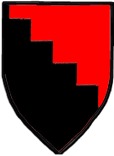
Per fess wavy sable and purpure
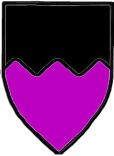
a lion rampant barry azure and argent

a bordure compony gules and Or
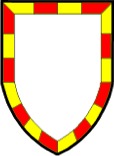
Quarterly azure and argent, a lion rampant sable
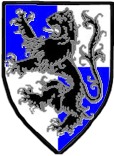
Per chevron Or and sable, a tree eradicated proper
